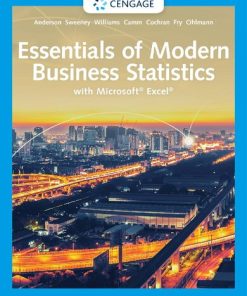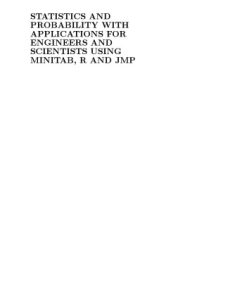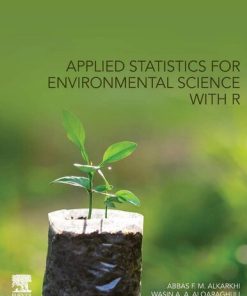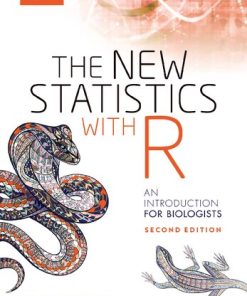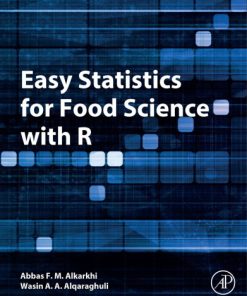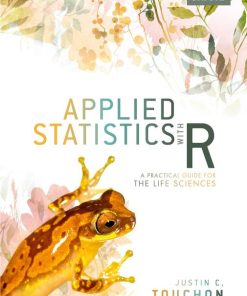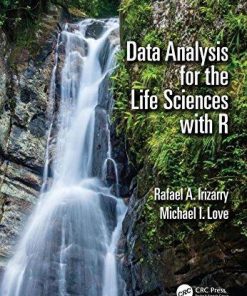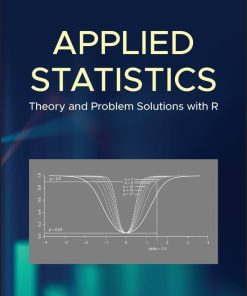Basic Statistics with R Reaching Decisions with Data 1st edition by Stephen Loftus 0128209264 9780128209264
$50.00 Original price was: $50.00.$25.00Current price is: $25.00.
Basic Statistics with R: Reaching Decisions with Data 1st edition by Stephen C. Loftus – Ebook PDF Instant Download/DeliveryISBN: 0128209264, 9780128209264
Full download Basic Statistics with R: Reaching Decisions with Data 1st edition after payment.
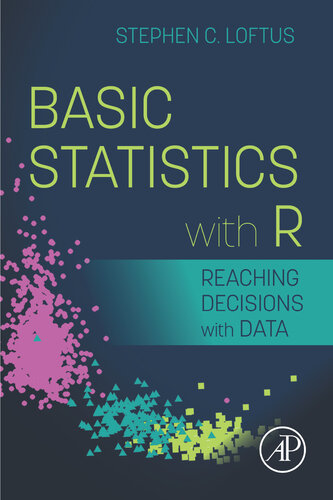
Product details:
ISBN-10 : 0128209264
ISBN-13 : 9780128209264
Author: Stephen C. Loftus
Basic Statistics with R: Reaching Decisions with Data provides an understanding of the processes at work in using data for results. Sections cover data collection and discuss exploratory analyses, including visual graphs, numerical summaries, and relationships between variables – basic probability, and statistical inference – including hypothesis testing and confidence intervals. All topics are taught using real-data drawn from various fields, including economics, biology, political science and sports. Using this wide variety of motivating examples allows students to directly connect and make statistics essential to their field of interest, rather than seeing it as a separate and ancillary knowledge area.
In addition to introducing students to statistical topics using real data, the book provides a gentle introduction to coding, having the students use the statistical language and software R. Students learn to load data, calculate summary statistics, create graphs and do statistical inference using R with either Windows or Macintosh machines.
Basic Statistics with R: Reaching Decisions with Data 1st Table of contents:
Part I: An introduction to statistics and R
Chapter 1: What is statistics and why is it important?
1.1. Introduction
1.2. So what is statistics?
1.3. Computation and statistics
References
Chapter 2: An introduction to R
2.1. Installation
2.2. Classes of data
2.3. Mathematical operations in R
2.4. Variables
2.5. Vectors
2.6. Data frames
2.7. Practice problems
2.8. Conclusion
References
Part II: Collecting data and loading it into R
Chapter 3: Data collection: methods and concerns
3.1. Introduction
3.2. Components of data collection
3.3. Observational studies
3.4. Designed experiments
3.5. Observational studies and experiments: which to use?
3.6. Conclusion
References
Chapter 4: R tutorial: subsetting data, random numbers, and selecting a random sample
4.1. Introduction
4.2. Subsetting vectors
4.3. Subsetting data frames
4.4. Random numbers in R
4.5. Select a random sample
4.6. Getting help in R
4.7. Practice problems
4.8. Conclusion
References
Chapter 5: R tutorial: libraries and loading data into R
5.1. Introduction
5.2. Libraries in R
5.3. Loading datasets stored in libraries
5.4. Loading csv files into R
5.5. Practice problems
5.6. Conclusion
References
Part III: Exploring and describing data
Chapter 6: Exploratory data analyses: describing our data
6.1. Introduction
6.2. Parameters and statistics
6.3. Parameters, statistics, and EDA for categorical variables
6.4. Parameters, statistics, and EDA for a single quantitative variable
6.5. Visual summaries for a single quantitative variables
6.6. Identifying outliers
6.7. Exploring relationships between variables
6.8. Exploring association between categorical predictor and quantitative response
6.9. Exploring association between two quantitative variables
6.10. Conclusion
References
Chapter 7: R tutorial: EDA in R
7.1. Introduction
7.2. Frequency and contingency tables in R
7.3. Numerical exploratory analyses in R
7.4. Missing data
7.5. Practice problems
7.6. Graphical exploratory analyses in R
7.7. Boxplots
7.8. Practice problems
7.9. Conclusion
References
Part IV: Mechanisms of inference
Chapter 8: An incredibly brief introduction to probability
8.1. Introduction
8.2. Random phenomena, probability, and the Law of Large Numbers
8.3. What is the role of probability in inference?
8.4. Calculating probability and the axioms of probability
8.5. Random variables and probability distributions
8.6. The binomial distribution
8.7. The normal distribution
8.8. Practice problems
8.9. Conclusion
Chapter 9: Sampling distributions, or why exploratory analyses are not enough
9.1. Introduction
9.2. Sampling distributions
9.3. Properties of sampling distributions and the central limit theorem
9.4. Practice problems
9.5. Conclusion
Chapter 10: The idea behind testing hypotheses
10.1. Introduction
10.2. A lady tasting tea
10.3. Hypothesis testing
10.4. Practice problems
10.5. Conclusion
References
Chapter 11: Making hypothesis testing work with the central limit theorem
11.1. Introduction
11.2. Recap of the normal distribution
11.3. Getting probabilities from the normal distributions
11.4. Connecting data to p-values
11.5. Conclusion
Chapter 12: The idea of interval estimates
12.1. Introduction
12.2. Point and interval estimates
12.3. When intervals are “right”
12.4. Confidence intervals
12.5. Creating confidence intervals
12.6. Interpreting confidence intervals
12.7. Practice problems
12.8. Conclusion
References
Part V: Statistical inference
Chapter 13: Hypothesis tests for a single parameter
13.1. Introduction
13.2. One-sample test for proportions
13.3. One-sample t-test for means
13.4. Conclusion
References
Chapter 14: Confidence intervals for a single parameter
14.1. Introduction
14.2. Confidence interval for p
14.3. Confidence interval for μ
14.4. Other uses of confidence intervals
14.5. Conclusion
References
Chapter 15: Hypothesis tests for two parameters
15.1. Introduction
15.2. Two-sample test for proportions
15.3. Two-sample t-test for means
15.4. Paired t-test for means
15.5. Conclusion
References
Chapter 16: Confidence intervals for two parameters
16.1. Introduction
16.2. Confidence interval for p1−p2
16.3. Confidence interval for μ1−μ2
16.4. Confidence intervals for μD
16.5. Confidence intervals for μ1−μ2, μD, and hypothesis testing
16.6. Conclusion
References
Chapter 17: R tutorial: statistical inference in R
17.1. Introduction
17.2. Choosing the right test
17.3. Inference for proportions
17.4. Inference for means
17.5. Conclusion
References
Chapter 18: Inference for two quantitative variables
18.1. Introduction
18.2. Test for correlations
18.3. Confidence intervals for correlations
18.4. Test for correlations in R
18.5. Confidence intervals for correlations
18.6. Practice problems
18.7. Conclusion
References
Chapter 19: Simple linear regression
19.1. Introduction
19.2. Basic of lines
19.3. The simple linear regression model
19.4. Estimating the regression model
19.5. Regression in R
19.6. Practice problems
19.7. Using regression to create predictions
19.8. Practice problems
19.9. The assumptions of regression
19.10. Inference for regression
19.11. How good is our regression?
19.12. Practice problems
19.13. Conclusion
References
Chapter 20: Statistics: the world beyond this book
20.1. Questions beyond the techniques of this book
20.2. The answers statistics gives
20.3. Where does this leave us?
People also search for Basic Statistics with R: Reaching Decisions with Data 1st:
basic statistics with r reaching decisions with data
basic statistics with r reaching decisions with data pdf
basic decision problems
basic statistics in r programming
basic statistics review
Tags: Basic Statistics, Reaching Decisions, Stephen Loftus, understanding, the processes
You may also like…
Computers - Applications & Software
Applied Statistics for Environmental Science With R 1st Edition
Mathematics
Computers - Programming
Easy Statistics for Food Science with R 1st Edition Abdulraheem Alqaraghuli
Mathematics - Mathematical Statistics
Applied Statistics with R: A Practical Guide for the Life Sciences
Uncategorized





